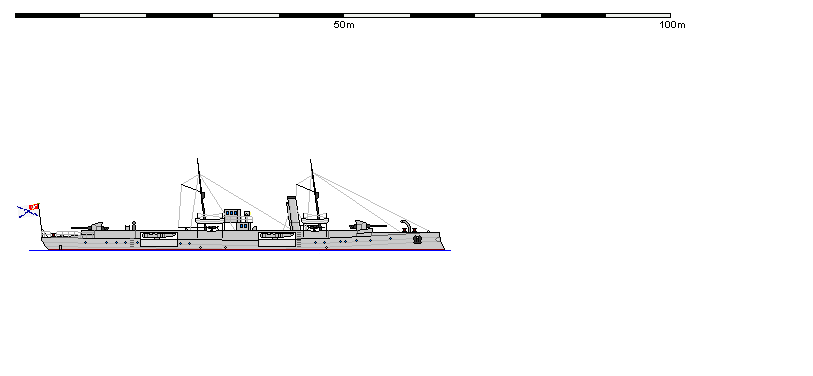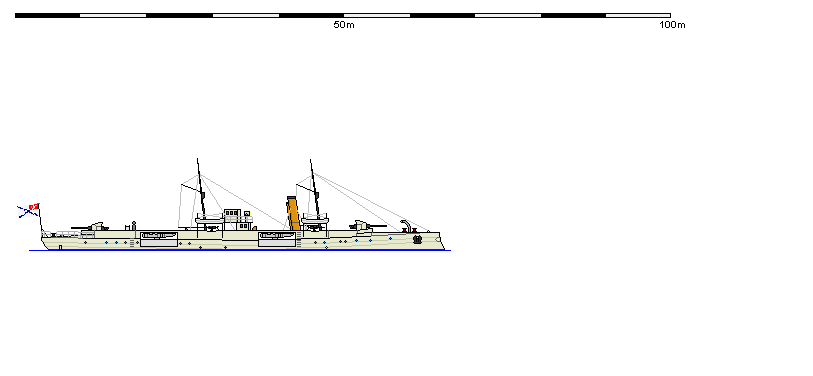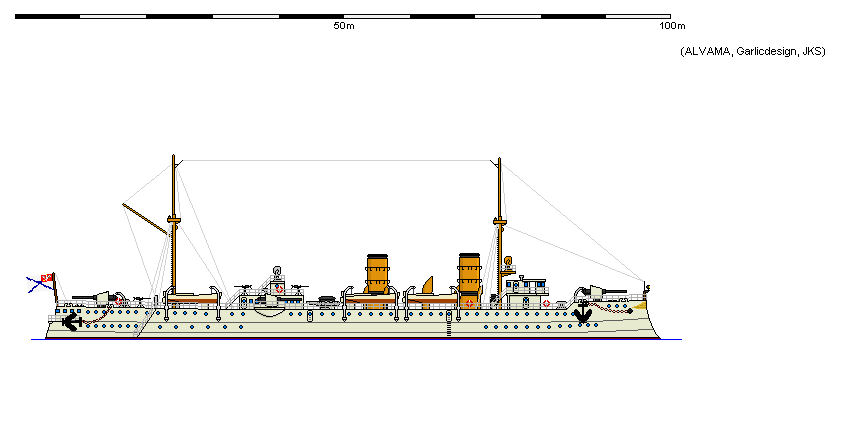Dzisiejszy „okręt” to improwizowana jednostka - barka
artyleryjska mająca służyć do ochrony portu w Lipawie. Jest to rozwiązanie
tymczasowe podyktowane koniecznością wycofania starych, pochodzących jeszcze z
lat 60-tych XIX w., monitorów z działami gładkolufowymi a także chęcią
zagospodarowania dział zdjętych z pancerników typu Władysław Jagiełło.
Jednostki w zasadzie nie mają się nigdzie ruszać poza bazę, stąd takie a nie
inne ich charakterystyki odnośnie prędkości, zasięgu i proporcji kadłuba. Nad
stacjonarną artylerią brzegową mają natomiast jedną przewagę, polegającą na
tym, że w chwili ewentualnego ataku przeciwnik nigdy nie będzie wiedział w
którym miejscu bazy czy jej sąsiedztwa barki
mające działa są rozmieszczone. Stąd zawsze ich ogień zawsze może
stanowić dla niego jakieś zaskoczenie, zwiększając szanse obrońców na odparcie
ataku.
Mątwa, polish artillery barge laid down 1902
Displacement:
748 t light; 810 t standard; 815 t normal; 818 t full load
Dimensions: Length overall / water x beam x draught
122,28 ft / 120,28 ft x 59,22 ft x 6,66 ft (normal load)
37,27 m / 36,66 m x 18,05 m x 2,03 m
Armament:
1 - 17,01" / 432 mm guns in single mounts, 2 090,93lbs / 948,43kg shells, 1880 Model
Breech loading gun in deck mount
on centreline forward
Weight of broadside 2 091 lbs / 948 kg
Shells per gun, main battery: 40
Machinery:
Coal fired boilers, complex reciprocating steam engines,
Direct drive, 1 shaft, 7 ihp / 6 Kw = 3,00 kts
Range 100nm at 2,00 kts
Bunker at max displacement = 8 tons (100% coal)
Complement:
76 - 99
Cost:
£0,246 million / $0,983 million
Distribution of weights at normal displacement:
Armament: 261 tons, 32,1%
Machinery: 1 tons, 0,1%
Hull, fittings & equipment: 486 tons, 59,6%
Fuel, ammunition & stores: 67 tons, 8,2%
Miscellaneous weights: 0 tons, 0,0%
Overall survivability and seakeeping ability:
Survivability (Non-critical penetrating hits needed to sink ship):
245 lbs / 111 Kg = 0,1 x 17,0 " / 432 mm shells or 0,3 torpedoes
Stability (Unstable if below 1.00): 2,45
Metacentric height 8,9 ft / 2,7 m
Roll period: 8,4 seconds
Steadiness - As gun platform (Average = 50 %): 53 %
- Recoil effect (Restricted arc if above 1.00): 0,08
Seaboat quality (Average = 1.00): 1,06
Hull form characteristics:
Hull has a flush deck
Block coefficient: 0,601
Length to Beam Ratio: 2,03 : 1
'Natural speed' for length: 10,97 kts
Power going to wave formation at top speed: 8 %
Trim (Max stability = 0, Max steadiness = 100): 50
Bow angle (Positive = bow angles forward): 5,00 degrees
Stern overhang: 1,48 ft / 0,45 m
Freeboard (% = measuring location as a percentage of overall length):
- Stem: 6,00 ft / 1,83 m
- Forecastle (24%): 5,48 ft / 1,67 m
- Mid (50%): 5,48 ft / 1,67 m
- Quarterdeck (15%): 5,48 ft / 1,67 m
- Stern: 5,48 ft / 1,67 m
- Average freeboard: 5,53 ft / 1,69 m
Ship tends to be wet forward
Ship space, strength and comments:
Space - Hull below water (magazines/engines, low = better): 226,9%
- Above water (accommodation/working, high = better): 70,0%
Waterplane Area: 5 101 Square feet or 474 Square metres
Displacement factor (Displacement / loading): 39%
Structure weight / hull surface area: 90 lbs/sq ft or 440 Kg/sq metre
Hull strength (Relative):
- Cross-sectional: 0,88
- Longitudinal: 3,29
- Overall: 1,00
Hull space for machinery, storage, compartmentation is extremely poor
Room for accommodation and workspaces is cramped
Mątwa (1902)
Krab (1902)
Langusta (1903)
Garnela (1903)
Displacement:
748 t light; 810 t standard; 815 t normal; 818 t full load
Dimensions: Length overall / water x beam x draught
122,28 ft / 120,28 ft x 59,22 ft x 6,66 ft (normal load)
37,27 m / 36,66 m x 18,05 m x 2,03 m
Armament:
1 - 17,01" / 432 mm guns in single mounts, 2 090,93lbs / 948,43kg shells, 1880 Model
Breech loading gun in deck mount
on centreline forward
Weight of broadside 2 091 lbs / 948 kg
Shells per gun, main battery: 40
Machinery:
Coal fired boilers, complex reciprocating steam engines,
Direct drive, 1 shaft, 7 ihp / 6 Kw = 3,00 kts
Range 100nm at 2,00 kts
Bunker at max displacement = 8 tons (100% coal)
Complement:
76 - 99
Cost:
£0,246 million / $0,983 million
Distribution of weights at normal displacement:
Armament: 261 tons, 32,1%
Machinery: 1 tons, 0,1%
Hull, fittings & equipment: 486 tons, 59,6%
Fuel, ammunition & stores: 67 tons, 8,2%
Miscellaneous weights: 0 tons, 0,0%
Overall survivability and seakeeping ability:
Survivability (Non-critical penetrating hits needed to sink ship):
245 lbs / 111 Kg = 0,1 x 17,0 " / 432 mm shells or 0,3 torpedoes
Stability (Unstable if below 1.00): 2,45
Metacentric height 8,9 ft / 2,7 m
Roll period: 8,4 seconds
Steadiness - As gun platform (Average = 50 %): 53 %
- Recoil effect (Restricted arc if above 1.00): 0,08
Seaboat quality (Average = 1.00): 1,06
Hull form characteristics:
Hull has a flush deck
Block coefficient: 0,601
Length to Beam Ratio: 2,03 : 1
'Natural speed' for length: 10,97 kts
Power going to wave formation at top speed: 8 %
Trim (Max stability = 0, Max steadiness = 100): 50
Bow angle (Positive = bow angles forward): 5,00 degrees
Stern overhang: 1,48 ft / 0,45 m
Freeboard (% = measuring location as a percentage of overall length):
- Stem: 6,00 ft / 1,83 m
- Forecastle (24%): 5,48 ft / 1,67 m
- Mid (50%): 5,48 ft / 1,67 m
- Quarterdeck (15%): 5,48 ft / 1,67 m
- Stern: 5,48 ft / 1,67 m
- Average freeboard: 5,53 ft / 1,69 m
Ship tends to be wet forward
Ship space, strength and comments:
Space - Hull below water (magazines/engines, low = better): 226,9%
- Above water (accommodation/working, high = better): 70,0%
Waterplane Area: 5 101 Square feet or 474 Square metres
Displacement factor (Displacement / loading): 39%
Structure weight / hull surface area: 90 lbs/sq ft or 440 Kg/sq metre
Hull strength (Relative):
- Cross-sectional: 0,88
- Longitudinal: 3,29
- Overall: 1,00
Hull space for machinery, storage, compartmentation is extremely poor
Room for accommodation and workspaces is cramped
Mątwa (1902)
Krab (1902)
Langusta (1903)
Garnela (1903)

















